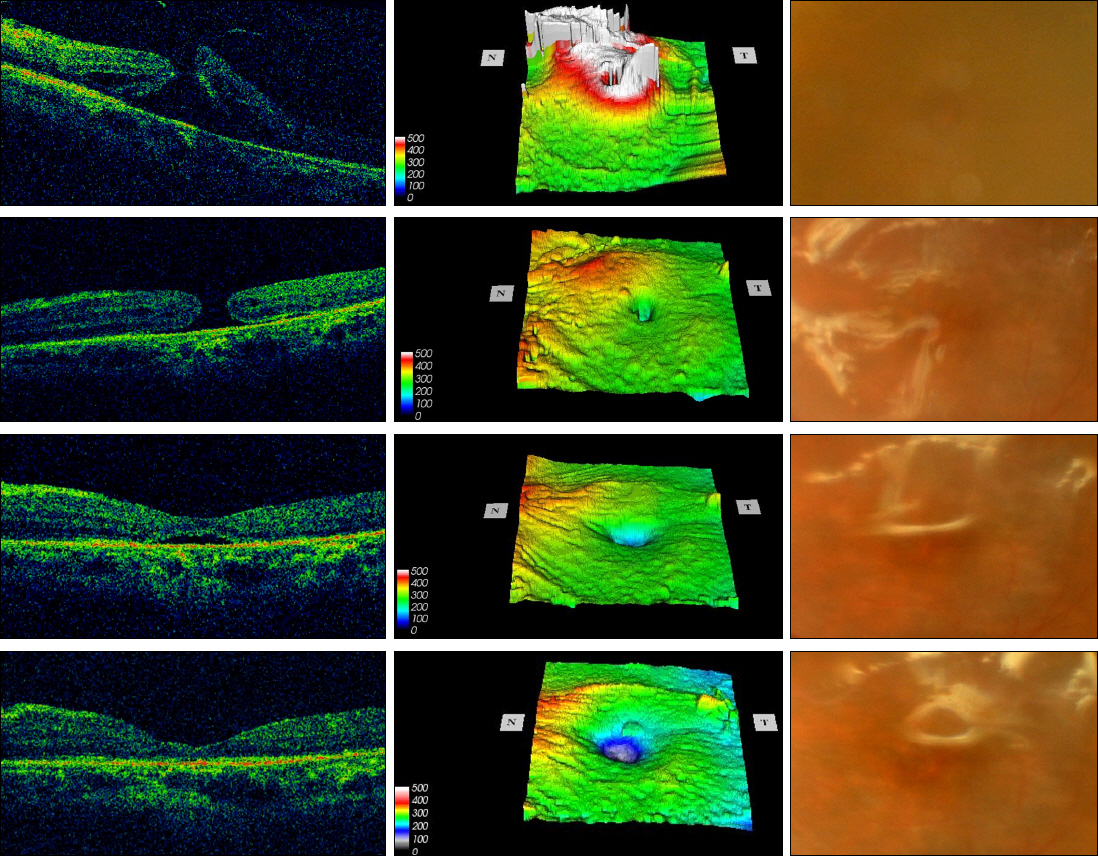J Korean Ophthalmol Soc.
2013 Apr;54(4):686-690. 10.3341/jkos.2013.54.4.686.
Delayed Sealing of Macular Hole after Vitrectomy with Silicone Oil Tamponade
- Affiliations
-
- 1Department of Ophthalmology, Korea University College of Medicine, Seoul, Korea. ojr4991@yahoo.co.kr
- KMID: 2216956
- DOI: http://doi.org/10.3341/jkos.2013.54.4.686
Abstract
- PURPOSE
To report a case of delayed sealing of full-thickness macular hole associated with diabetic retinopathy after vitrectomy with silicone oil tamponade.
CASE SUMMARY
A 63-year-old woman visited our clinic complaining of decreased visual acuity in her left eye. Fundoscopy showed a full-thickness macular hole with vitreomacular traction in the left eye and bilateral proliferative diabetic retinopathy. The patient underwent uncomplicated phacoemulsification and pars plana vitrectomy with silicone oil tamponade because her vision in the contralateral eye was only light perception. She was unable to maintain a prone position postoperatively due to anterior chamber hyphema. At 1.5 months after surgery, vitreomacular traction was removed but the hole was not sealed as observed on optical coherence tomography. Approximately 3 months after vitrectomy, the macular hole was sealed with minimal subfoveal fluid. At 6 months after vitrectomy, the macular hole was closed completely with no subfoveal fluid.
MeSH Terms
Figure
Cited by 1 articles
-
Delayed Closure of Idiopathic Macular Hole after Vitrectomy, Internal Limiting Membrane Peeling, and Gas Tamponade
Jong Heon Lee, Ho Yun Kim, Sung Who Park, Ji Eun Lee, Ik Soo Byon
J Korean Ophthalmol Soc. 2014;55(5):775-779. doi: 10.3341/jkos.2014.55.5.775.
Reference
-
References
1. Morgan CM, Schatz H. Idiopathic macular holes. Am J Ophthalmol. 1985; 99:437–44.
Article2. Yeh PT, Cheng CK, Chen MS, et al. Macular hole in proliferative diabetic retinopathy with fibrovascular proliferation. Retina. 2009; 29:355–61.
Article3. Garcia-Arumi J, Corcostegui B, Cavero L, et al. The role of vitreoretinal surgery in the treatment of posttraumatic macular hole. Retina. 1997; 17:372–7.
Article4. Ho AC, Guyer DR, Fine SL. Macular hole. Surv Ophthalmol. 1998; 42:393–416.
Article5. Kwok AK, Cheng LL, Gopal L, et al. Endolaser around macular hole in the management of associated retinal detachment in highly myopic eyes. Retina. 2000; 20:439–44.
Article6. Kelly NE, Wendel RT. Vitreous surgery for idiopathic macular holes. Results of a pilot study. Arch Ophthalmol. 1991; 109:654–9.
Article7. Lee JE, Oum BS. Macular hole surgery with or without indocyanine green-assisted internal limiting membrane peeling. J Korean Ophthalmol Soc. 2003; 44:2553–9.8. Johnson RN, Gass JD. Idiopathic macular holes. Observations, stages of formation, and implications of surgical intervention. Ophthalmology. 1988; 95:917–24.
Article9. Chew EY, Sperduto RD, Hiller R, et al. Clinical course of macular holes: the Eye Disease Case-Control Study. Arch J Ophthalmol. 1999; 117:242–6.10. Evans JR, Schwartz SD, McHugh JD, et al. Systemic risk factors for idiopathic macular hole: a case-control study. Eye (Lond). 1998; 12:256–9.11. Ghoraba H. Type of macular holes encountered during diabetic vitrectomy. Retina. 2002; 22:176–82.12. Lai JC, Stinnett SS, McCuen BW. Comparison of silicone oil versus gas tamponade in the treatment of idiopathic full-thickness macular hole. Ophthalmology. 2003; 110:1170–4.
Article13. Goldbaum MH, McCuen BW, Hanneken AM, et al. Silicone oil tamponade to seal macular holes without position restrictions. Ophthalmology. 1998; 105:2140–7.
Article14. Pertile G, Claes C. Silicone oil vs. gas for the treatment of full-thickness macular hole. Bull Soc Belge Ophtalmol. 1999; 274:31–6.15. Voo I, Siegner SW, Small KW. Silicone oil tamponade to seal macular holes. Ophthalmology. 2001; 108:1516–7.
Article16. Thompson JT, Smiddy WE, Glaser BM, et al. Intraocular tamponade duration and success of macular hole surgery. Retina. 1996; 16:373–82.
Article17. Chandra A, Charteris DG, Yorston D. Posturing after macula hole surgery: a review. Ophthalmologica. 2011; 226:3–9.18. Yorston D, Siddiqui MA, Awan MA, et al. Pilot randomized controlled trial of face-down posturing following phacovitrectomy for macular hole. Eye (Lond). 2012; 26:267–71.19. Oster SF, Mojana F, Bartsch DU, et al. Dynamics of the macular hole-silicone oil tamponade interface with patient positioning as imaged by spectral domain-optical coherence tomography. Retina. 2010; 30:924–9.
Article20. D'Souza MJ, Chaudhary V, Devenyi R, et al. Re-operation of idiopathic full-thickness macular holes after initial surgery with internal limiting membrane peel. Br J Ophthalmol. 2011; 95:1564–7.21. Xirou T, Xirou V, Mangouritsas , et al. Full thickness macular hole clusure after exchanging silicone-oil tamponade with C(3)F(8) without posturing. Case Report Ophthalmol. 2011; 2:166–9.22. Georgalas I, Ezra E. Delayed closure after surgery for a full-thickness macular hole in a highly myopic eye. Can J Ophthalmol. 2007; 42:341–2.
Article23. Wong SC, Neuwelt MD, Trese MT. Delayed closure of pediatric macular hole in Coats' disease. Acta Ophthalmol. 2012; 90:e326–7.24. Muselier A, Dugas B, Burelle X, et al. Macular hole surgery and cataract extraction: combined vs consecutive surgery. Am J Ophthalmol. 2010; 150:387–91.
Article
- Full Text Links
- Actions
-
Cited
- CITED
-
- Close
- Share
- Similar articles
-
- Primary Silicone Oil Tamponade with Vitrectomy in Macular Hole Retinal Detachment of Highly Myopic Eyes
- Silicone Oil with Short-Term Prone Position in Macular Hole Retinal Detachment Surgery in High Myopia
- Case of Macular Hole after Surgery in Macular Detachment with Optic Disc Pit in a Child
- A Case of Macular Hole after Exposure to Tattoo Removal by Q-Switched Neodymium:YAG Laser
- Therapeutic Effect of High Viscosity Silicone Oil for Treatment of Refractory Macular Hole: A Case Report


